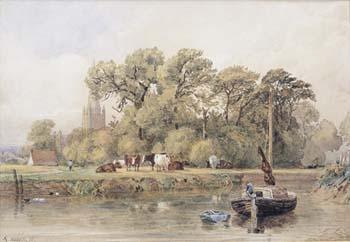
Edward Winter

C.N. 5007 showed this water-colour painting, courtesy of its owner Eric Fisher (Hull, England). The artist was Samuel Standidge Boden (1826-82), whose obituary on pages 167-168 of the Chess Monthly, February 1882 referred to him as a landscape painter and art critic, also describing him as ‘one of the best chessplayers England ever produced’. Page 31 of the Chess Player’s Chronicle, 18 January 1882 stated that ‘on coming into some property, through the death of a relative, he entirely devoted himself to art’.
This sketch of Boden comes from page 553 of Brentano’s Chess Monthly, March 1882:
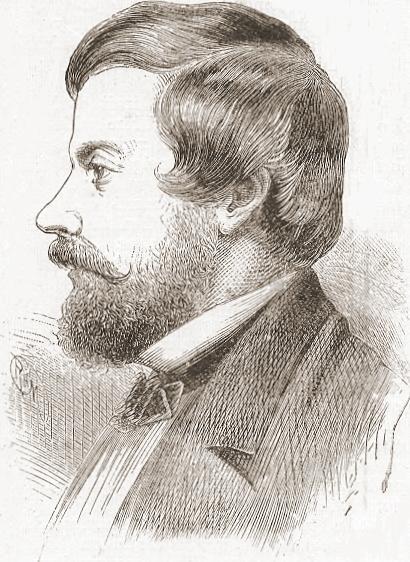
Boden’s most famous chess game is a 15-move brilliancy against Schulder which was discussed in a number of items (C.N.s 292, 378, 428, 474, 531 and 578) in 1983. Here, we offer an expanded overview of the game which gave rise to the term ‘Boden’s mate’:
1 e4 e5 2 Nf3 d6 3 c3 f5 4 Bc4 Nf6 5 d4 fxe4 6 dxe5 exf3 7 exf6 Qxf6 8 gxf3 Nc6 9 f4 Bd7 10 Be3 O-O-O 11 Nd2 Re8 12 Qf3 Bf5 13 O-O-O d5 14 Bxd5 Qxc3+ 15 bxc3 Ba3 mate.
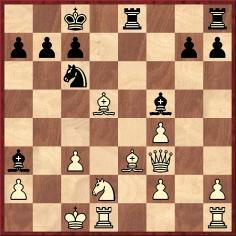
C.N. 292 pointed out the dismayingly similar entries on ‘Boden’s Mate’ in two reference books. Firstly, page 35 of The Encyclopaedia of Chess by Anne Sunnucks (London, 1970):

From page 40 of An illustrated Dictionary of Chess by Edward R. Brace (London, 1977):
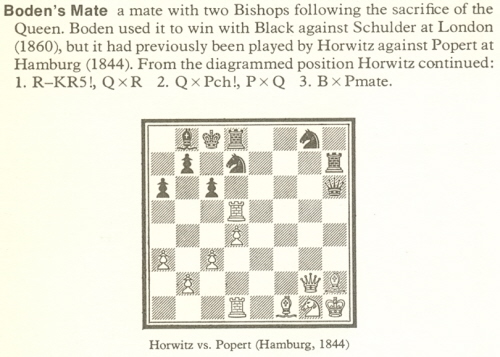
‘London, 1860’ was also specified by Walter Korn on page 50 of Chess Review, February 1961. See too, for example, pages 157-158 of The Joys of Chess by F. Reinfeld (New York, 1961). Page 128 of Ajedrez esencial by A. López Manzano and J. Monedero González (Barcelona, 2002) had ‘London, 1844’. The game was ‘played about 1851’ according to page 16 of Chess Sparks by J.H. Ellis (London, 1895). L’art de faire mat (English edition: The Art of the Checkmate) by G. Renaud and V. Kahn presented the position (as Exercise No. 21) as played around 1853 (‘vers 1853’), stating that White was ‘Schulten’. The year 1865 was given on page 200 of 500 Master Games of Chess by S. Tartakower and J. du Mont (London, 1952), whose index had an initial for White: R. Schulder (It also had ‘A. Boden’.) The index to 200 Miniature Games of Chess by J. du Mont (London, 1941) gave Schulten’s forename as Richard (possibly through confusion with a later player of that name). Schulten was described as ‘a strong German amateur’ when his loss to Boden was printed on page 173 of the 15 August 1884 Brooklyn Chess Chronicle. At present, we would venture to affirm nothing about him beyond the surname Schulder.
Page 76 of The Art of Attack in Chess by V. Vuković (Oxford, 1965) gave the position before 14...Qxc3+ (minus the black rook on e8), stating that it came ‘from the game Macdonell [sic]-Boden (1869)’. That was amended to ‘Schulder-Boden, London, 1853’ on page 76 of the algebraic edition edited by John Nunn (London, 1998). Vuković’s reference to MacDonnell v Boden was evidently based on confusion with another brilliancy by Boden (20...Qxf3) which was also given in the Tartakower/du Mont book (see pages 248-249). Unsurprisingly, there are discrepancies regarding that game too. For instance, page 31 of Combination in Chess by G. Négyesy and J. Hegyi (Budapest, 1965) dated it 1830, the year in which MacDonnell was born.
Both Boden games were given in the 25 January 1882 issue of the Chess Player’s Chronicle (pages 40-41), which said that the Schulder game was ‘played soon after 1851’. The two games also appeared on pages 62-63 of H.E. Bird’s Chess Masterpieces (London, 1875). Bird’s note to 8 gxf3 in Schulder v Boden was:
‘Some players consider changing queens detracts somewhat from the interest of the game. Mr Schulder we happen to know was one of them.’
Bird gave no date for the game, but publication can be traced
back to two British periodicals in or around 1853. From page 253
of the third volume (1852-53) of the Chess Player:

Below is the game-score as it appeared on page 58 of the British Chess Review, 1853:
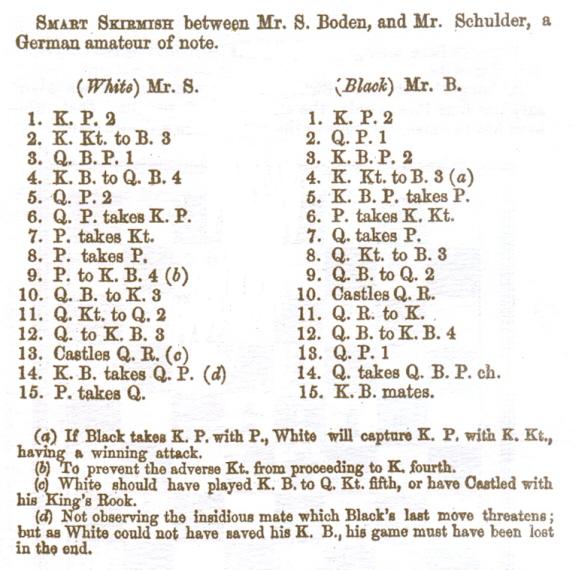
From the bound volumes of the two magazines the publication dates of individual issues are seldom clear. Neither periodical specified that the game was played in 1853 (or, indeed, that the venue was London, as is commonly assumed). The question which therefore arises is whether the game-score can be traced in newspaper columns of the early 1850s.
The Chess Player contained a number of other games by Schulder. Below, from pages 65-66 of the 1852-53 volume, is a victory over Boden:
Schulder – Samuel Standidge Boden1 e4 e5 2 Nf3 d6 3 Bc4 Be7 4 d4 exd4 5 Nxd4 Nf6 6 Nc3 O-O 7 O-O Nxe4 8 Nxe4 d5 9 Bxd5 Qxd5 10 Ng3 Nc6 11 Nxc6 Qxc6 12 c3 b6 13 f3 f5 14 Bf4 Ba6 15 Re1 Rad8 16 Qc2 Bd3 17 Qb3+ Bc4 18 Qc2 Bc5+ 19 Kh1 Kh8 20 Rad1 Rxd1 21 Rxd1 Be6 22 b3 h6 23 c4 Be7 24 Be5 Kh7

25 Ne2 Bc8 26 Nf4 g6 27 Qb2 Qc5 28 a3 c6 29 h4 g5 30 Nd3 Qe3 31 Qc2 Rd8 32 Bb2 gxh4 33 Re1 Qxd3 34 Rxe7+ Kg6 35 Qf2 Kh5 36 Bf6 Rg8 37 Qxh4+ Kg6 38 Be5 Resigns.
Further games played by Schulder will be given in a future C.N. item. We shall also be dipping a wary toe into another casse-tête: the Horwitz v Popert position mentioned above in the Sunnucks and Brace entries on Boden’s mate.
The above article originally appeared at ChessBase.com.
Below are some other games played by the mysterious Schulder:
Daniel Harrwitz – Schulder
Occasion?
Dutch Defence
1 d4 f5 2 c4 d6 3 Nc3 e6 4 f4 Nf6 5 Nf3 Nbd7 6 e3 b6 7 Ng5 Qe7 8 Nb5 Kd8 9 Qf3 d5 10 b3 h6 11 Nh3 a6 12 Nc3 Bb7 13 Be2 c5 14 Nf2 cxd4 15 exd4 Kc7 16 cxd5 Nxd5 17 Nxd5+ Bxd5 18 Qc3+ Kb7 19 O-O g5 20 Nd3 Rc8 21 Qd2 g4 22 Ne5 Nxe5 23 fxe5 h5 24 Qd3 b5 25 a4 Be4 26 Qd2 b4 27 Bc4 h4 28 Qe2 Rc6 29 Be3 h3 30 g3 Qd7 31 a5 Be7 32 Ra4 Rhc8 33 Raa1 Bd5 34 Rfc1 Be4 35 Ra2 Qd8
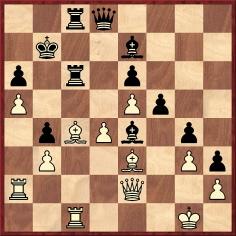
36 Bxa6+ Rxa6 37 Qb5+ Rb6 38 Qxb6+ Qxb6 39 axb6 Rxc1+ 40 Bxc1 Kxb6 41 Kf2 Bd5 42 Bd2 Kb5 43 Rb2 Bd8 44 Ke2 Bb6 45 Be3 Bd8 46 Kd3 Be4+ 47 Kd2 Bd5 48 Rb1 Bb6 49 Kc1 f4 50 gxf4 g3 51 Rb2 g2 52 Kd2 Bd8 53 Ke2 Bh4 54 Bg1 Kc6 55 Ke3 Be1 56 Ra2 Bxb3 57 Ra6+ Kb5 58 Ra8 Bc2
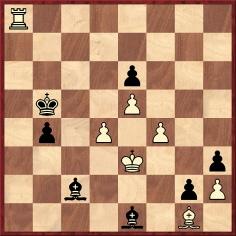
59 d5 exd5 60 e6 Bh4 61 Kd4 b3 62 Kxd5 Kb4 63 Rb8+ Kc3 64 Ke5 Kd2 65 f5 Ke2 66 f6 Kf1 67 Bd4
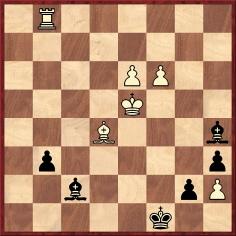
67...Bg3+ 68 hxg3 h2 69 f7 g1(Q) 70 f8(Q)+ Ke2 71 Qf4 Qg2 72 Qe3+ Kd1 73 Rd8 Resigns.
Source: Chess Player, October 1852, pages 50-51, with a correction on page 143 regarding White’s identity.
Schulder – Daniel Harrwitz
Occasion?
Sicilian Defence
1 e4 c5 2 c4 e6 3 b3 Nc6 4 Bb2 d6 5 g3 Nd4 6 Bg2 Ne7 7 Na3 g6 8 Nc2 Bg7 9 Nxd4 cxd4 10 d3 f5 11 exf5 Nxf5 12 Qe2 Qa5+ 13 Kd1 O-O 14 h4 Bh6 15 g4 Ne7 16 Bxd4 e5 17 Be3
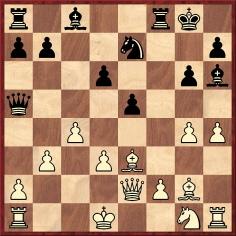
17...Bxg4 18 Qxg4 Bxe3 19 fxe3 Qc3 20 Rc1 Qxd3+ 21 Ke1 Qxe3+ 22 Ne2 Qf2+ 23 Kd1 Nf5 24 Kd2 Qe3+ 25 Kc2 Qb6 26 Bd5+ Kh8 27 Kb1 Ne3 28 Qe4 Rf2 29 c5 Qb5 30 Qxe3 Rxe2 31 Qf3 Rf2 32 Qxf2 Qd3+ 33 Ka1 Qxd5 34 Qf6+ Kg8 35 Rhd1 Qe4 36 cxd6 Rf8 37 Qe6+ Kh8 38 d7 Qxh4 39 Rc8 Rd8 40 Rxd8+ Resigns.
Source: Chess Player, 1852, page 62.
Bernhard Horwitz – Schulder
Occasion?
Queen’s Gambit Accepted
1 d4 d5 2 c4 dxc4 3 e4 e5 4 d5 f5 5 Nc3 Nf6 6 Bg5 Bd6 7 Bxc4 O-O 8 Nf3 h6 9 Bxf6 Qxf6 10 Qe2 a6 11 a3 b5 12 Ba2 b4 13 axb4 Bxb4 14 O-O Bd6 15 Rae1 f4 16 Bc4 a5 17 h3 Nd7 18 Nh2 Nc5 19 Qh5 Kh7 20 Ng4 Bxg4 21 hxg4 g6 22 Qh3 Rab8 23 Re2 Rb4 24 Ba2 f3 25 gxf3 Nd3 26 Rd2 Nf4 27 Qg3 h5 28 Ne2 h4 29 Qh2 g5 30 Nxf4 exf4 31 Rc1 Rxb2
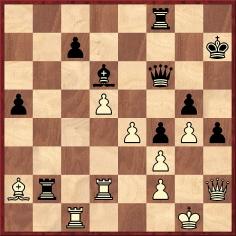
32 Bb1 Kg7 33 Rdd1 Rfb8 34 Kg2 a4 35 Qg1 a3 36 Qe1 a2 37 Bd3 Qd4 38 e5 h3+ 39 Kh1 Qxd5 40 Be4 Qxe5 41 Rd5 Qe7 42 Qc3+ Kg8 43 Qc4 Kh8 44 Ra1 Rb1+ 45 Rd1 Rxa1 46 Rxa1 Rb1+ 47 Bxb1 Qe1+ 48 Kh2 Qxf2+ 49 Kxh3 Qg3 mate.
Source: Chess Player, 1852, pages 63-64.
Bernhard Horwitz – Schulder1 e4 e5 2 f4 d5 3 exd5 exf4 4 Nf3 Bd6 5 Bb5+ c6 6 dxc6 bxc6 7 Bc4 Nf6 8 O-O O-O 9 d4 Bg4 10 c3 Nbd7 11 b3 Ne4 12 Qc2 Ndf6 13 Bd3 Bxf3 14 Rxf3 Ng5 15 Rf1 Qc7 16 Na3 h6 17 Nc4 Nd5 18 Nxd6 Qxd6 19 Qf2 Ne6 20 Bd2 g5 21 Rfe1 Nf6 22 Re2 Kg7 23 Rae1 Rae8 24 h4 Nh5 25 Re5 f6 26 Ra5 Rf7 27 Bc4 Rfe7 28 Bxe6 Rxe6 29 Rxa7+ Kg6 30 Rxe6 Qxe6 31 c4 Ng3 32 Bb4 Qe4 33 Kh2 Qb1 34 h5+ Kf5 35 Ra5+ Kg4 36 Qf3+ Kh4 37 White resigns.
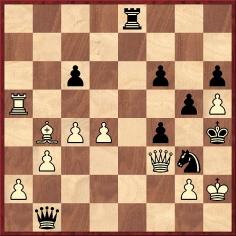
Source: Chess Player, 1852, pages 73-74.
Schulder – Simons
Occasion?
Philidor’s Defence
1 e4 e5 2 Nf3 d6 3 d4 exd4 4 Bc4 c6 5 O-O d5 6 exd5 cxd5 7 Bb3 Nf6 8 Qxd4 Nc6 9 Ba4 Be7 10 Ne5 Bd7 11 Nxc6 bxc6 12 Bg5 O-O 13 Nc3 Rb8 14 Rae1 Rb4 15 Qxa7 Rg4 16 f4 h6
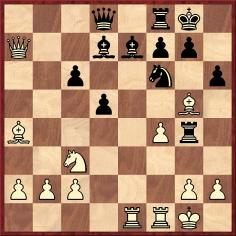
17 h3 hxg5 18 hxg4 Nxg4 19 Bxc6 gxf4 20 Bxd7 Ne3 21 Rxf4 Bg5 22 Rf3 Nxc2 23 Re2 d4 24 Rxc2 dxc3 25 Rcxc3 Qe7 26 Rcd3 Rc8 27 Rf1 Rd8 28 Rfd1 Bf4 29 Qf2 Qg5 30 g3 Rxd7 31 Qxf4 and wins.
Source: Chess Player, 1852-53, page 87.
Mr P. (‘one of the finest players of the day’) – Schulder
Occasion?
Sicilian Defence
1 e4 e6 2 f4 c5 3 Nf3 b6 4 d3 Bb7 5 Be2 d5 6 e5 Nh6 7 Be3 Ng4 8 Bg1 Nh6 9 Bf2 Nc6 10 O-O Be7 11 Nbd2 Rc8 12 d4 a6 13 c3 Nf5 14 Bd3 Nh6 15 h3 cxd4 16 Nxd4 Nxd4 17 Bxd4 f5 18 exf6 Bxf6 19 Qh5+ Nf7 20 Rae1 Bxd4+ 21 cxd4 Qf6 22 Nf3 g6 23 Qg4 Rc6
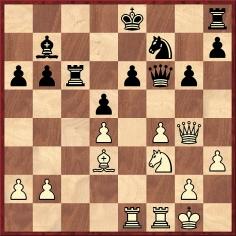
24 f5 gxf5 25 Bxf5 Ke7 26 Bxe6 Nh6 27 Bxd5+ Kd8 28 Qh5 Rc7 29 Re6 Qf4 30 Bxb7 Nf5 31 Re4 Ng3 32 Qd5+ Rd7 33 Qxd7+ Kxd7 34 Ne5+ Kc7 35 Rfxf4 Resigns.
Source: Chess Player, 1852-53, pages 105-106.
Frank Healey – Schulder1 e4 e5 2 Bc4 Qe7 3 Nc3 c6 4 Nge2 d6 5 O-O Be6 6 Bb3 g6 7 d4 Bxb3 8 axb3 Nd7 9 f4 Bg7 10 d5 f6 11 f5 gxf5 12 Rxf5 Nh6
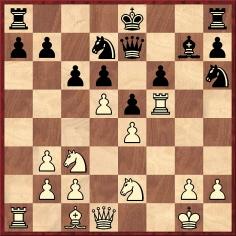
13 Ng3 Nxf5 14 Nxf5 Qf8 15 dxc6 bxc6 16 Nxd6+ Kd8 17 Be3 Kc7 18 Nf5 h5 19 Ra6 Rh7 20 Rxc6+ Kxc6 21 Qd5+ Kc7 22 Nb5+ Resigns.
Source: Chess Player’s Chronicle, 1859, pages 208-209.
Schulder – Frank Healey
Philidorian Chess Rooms, London, 3 June 1859
King Pawn’s Opening
1 e4 e5 2 g3 f5 3 d4 exd4 4 Bg2 Nc6 5 Ne2 fxe4 6 Bxe4 Bc5 7 Bd5 Nf6 8 c4 Nb4 9 Nf4 Nbxd5 10 Nxd5 O-O 11 O-O Nxd5 12 cxd5 d6 13 b4 Bxb4 14 Qxd4 Bc5 15 Qc3 Bh3 16 Bb2 Qe7 17 Nd2 Rf7 18 Rae1
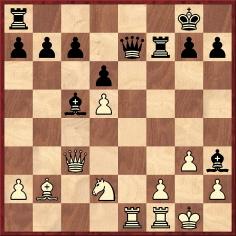
18...Rxf2 19 Rxf2 Qxe1+ 20 Nf1 Qxf1 mate.
Source: Chess Player’s Chronicle, 1859, pages 209-210.
Finally, we note on pages 316-317 of the British Chess Review, 1853 a comment about White’s fourth move in the first game of that year’s match between Löwenthal and Harrwitz, which began 1 e4 e5 2 f4 Bc5 3 Nf3 d6 4 b4:
‘This move, we are informed, is the invention of Mr Schulder, a strong German amateur, with whom this opening is a great favourite.’
(7341)
Gene Gnandt (Houston, TX, USA) draws attention to an item about Schulder on page 300 of the August 1849 Deutsche Schachzeitung:
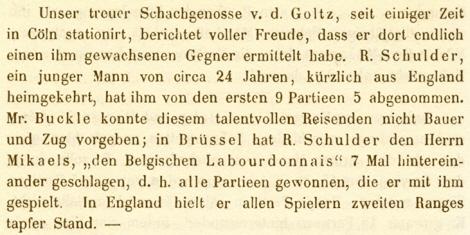
(7349)
C.N. 292 drew attention to the similar entries on page 35 of The Encyclopaedia of Chess by Anne Sunnucks (London, 1970) – as well as page 54 of the 1976 edition – and on page 40 of An illustrated Dictionary of Chess by Edward R. Brace (London, 1977):

Sunnucks

Brace
The Horwitz v Popert game was discussed by Richard Forster in his ‘Late Knight’ column at the Chess Café in September 2002, reference being made to pages 167-168 of volume two of Aus Vergangenen Zeiten by L. Bachmann (Berlin, 1920-22):
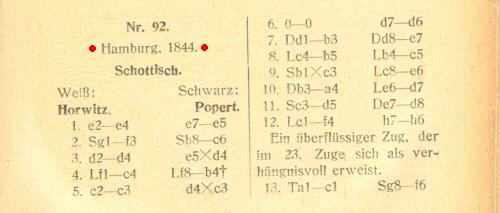
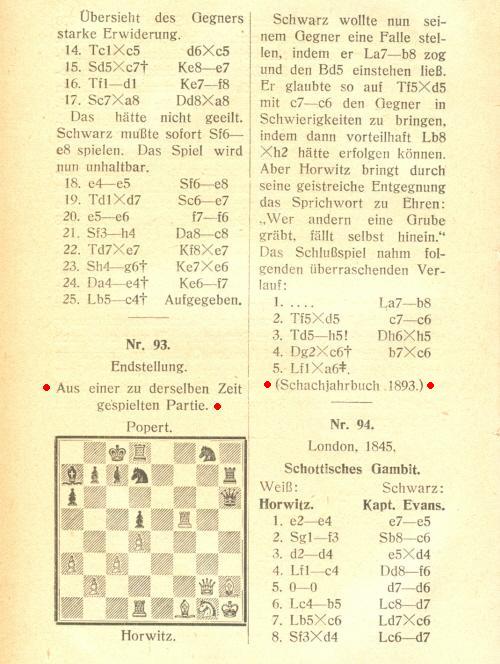
In his column the following month Richard Forster reported that a correspondent, Peter Anderberg, had found the position on page 108 of the Schachjahrbuch for 1894, not 1893. That source gave the occasion as Hamburg, 1844 and included two introductory moves:
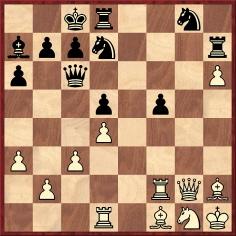
1…Qxh6 2 Rxf5 Bb8 3 Rxd5 c6 4 Rh5 Qxh5 5 Qxc6+ bxc6 6 Bxa6 mate.
That position had been given, without any venue or date, on page 137 of the 1 May 1847 issue of the Chess Player’s Chronicle:
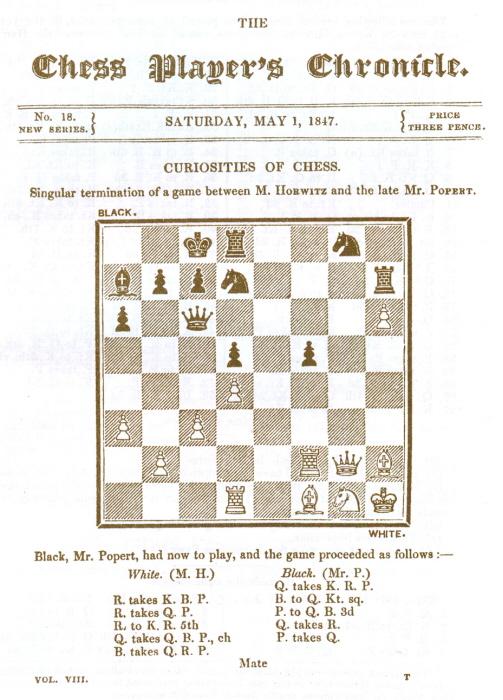
The reference to the ‘late Mr Popert’ will be noted. As regards his encounters with Horwitz, we reproduce a news item from page 234 of the 15 November 1842 issue of Le Palamède:
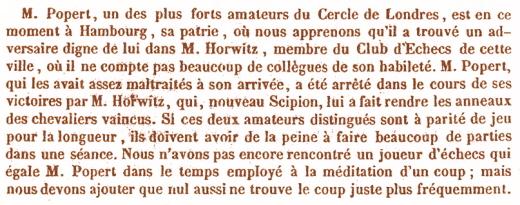
Finally, from pages 117-118 of the April 1847 Deutsche Schachzeitung (an article by von der Lasa entitled ‘Das Schachspiel in Hamburg und Altona’):
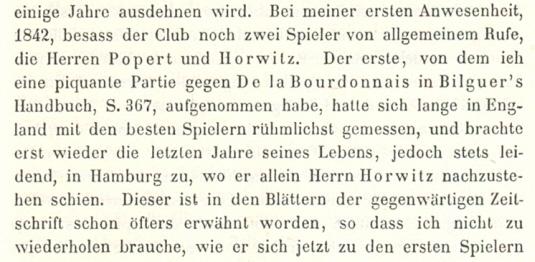

What more can be discovered about the Horwitz v Popert game, which is purportedly the first occurrence of ‘Boden’s Mate’? In particular, what is best corroboration available of the date 1844 and, of course, can the full game-score be traced?
(7364)
Regarding the famous game Canal v Amateur (1 e4 d5 2 exd5 Qxd5 3 Nc3 Qa5 4 d4 c6 5 Nf3 Bg4 6 Bf4 e6 7 h3 Bxf3 8 Qxf3 Bb4 9 Be2 Nd7 10 a3 O-O-O 11 axb4 Qxa1+ 12 Kd2 Qxh1 13 Qxc6+ bxc6 14 Ba6 mate) can the basic facts (the opponent’s name and the occasion) be established?
It is commonly stated that the game was played in a simultaneous exhibition in Budapest in 1934, but can that be proven? Surprisingly few chess periodicals of the time published the game-score, an exception being Chess Review (page 183 of the October 1934 issue). For the occasion it put ‘Played in a simultaneous exhibition’, which was also the limit of the information offered on page 521 of the December 1934 BCM.
Maverick suggestions include ‘France 1934’ on page 53 of The Art of Giving Mate by Attila Schneider (Kecskemét, 2003), but that is a book which began with a game by Greco dated 1875.
(5855)
Philip Corbin – Othneil Harewood
Barbados (friendly game), 1979
Sicilian Defence
1 e4 c5 2 d4 cxd4 3 c3 dxc3 4 Nxc3 Nc6 5 Nf3 e6 6 Bc4 Bb4 7 O-O Bxc3 8 bxc3 Na5 9 Bd3 Qc7 10 Qe2 Nc6 11 Ba3 Ne5 12 Nxe5 Qxe5 13 f4 Qc7 14 e5 Qxc3 15 Bd6 Ne7 16 Rac1 Qd4+ 17 Kh1 Nc6 18 f5 h5 19 fxe6 dxe6 20 Rxf7 Bd7 21 Qf3 O-O-O
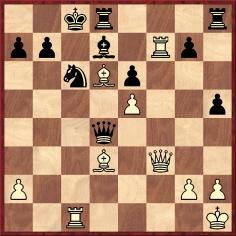
22 Qxc6+ Bxc6 23 Rxc6+ Resigns.
Source: pages 72-73 of Calypso Chess by Philip Corbin (Saint Peter, 2011).
(7373)
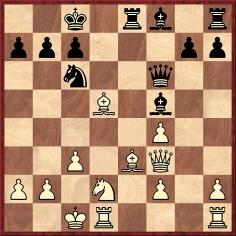
1) Schulder v Boden: Black played ...Qxc3+
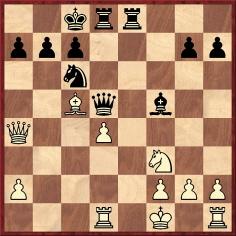
2) MacDonnell v Boden: Black played ...Qxf3
Regarding the first diagram, our article on Boden’s Mate commented:
‘Page 76 of The Art of Attack in Chess by V. Vuković (Oxford, 1965) gave the position before 14...Qxc3+ (minus the black rook on e8), stating that it came “from the game Macdonell [sic]-Boden (1869)”. That was amended to “Schulder-Boden, London, 1853” on page 76 of the algebraic edition edited by John Nunn (London, 1998). Vuković’s reference to MacDonnell v Boden was evidently based on confusion with another familiar brilliancy by Boden (20...Qxf3) which was also given in the Tartakower/du Mont book (see pages 248-249). Unsurprisingly, there are discrepancies regarding that game too. For instance, page 31 of Combination in Chess by G. Négyesy and J. Hegyi (Budapest, 1965) dated it 1830, the year in which MacDonnell was born.’
We wonder whether Vuković’s mistake was due to copying from Gutmayer, who frequently published the two queen sacrifices. In the list below an asterisk indicates that the games were confused:
(7406)
Pages 288-289 of the August 1850 Deutsche Schachzeitung published a game between Kieseritzky and Dumoncheau. White gave his queen’s rook and began with two moves; Black gave his f-pawn.
1 e4 2 d4 d5 3 e5 Be6 4 Bd3 Qd7 5 f4 Nh6 6 h3 Nf5 7 g4 Ng3 8 f5 Nxh1 9 fxe6 Qxe6 10 Qf3 g6 11 Nc3 c6 12 Nge2 c5 13 Bb5+ Nc6 14 Nf4 Qd7 15 e6 Qd6 16 Be3 c4 17 Nfxd5 O-O-O 18 Bxc4 Qg3+ 19 Ke2 Qh2+ 20 Kd3 h5 21 Bf4 Qg1

22 Nb6+ axb6 23 Qxc6+ bxc6 24 Ba6 mate.
Pages 120-121 of volume one of Aus Vergangenen Zeiten by Ludwig Bachmann (Berlin, 1920-22) stated that the game was played in Paris in 1844.
Richard Hervert (Aberdeen, MD, USA) notes that 500 Master Games of Chess by S. Tartakower and J. du Mont (London, 1952) did not refer to ‘Boden’s Mate’ in connection with Schulder v Boden; the finish was described on page 200 as a ‘diagonal cross-mate’. Can instances of the term ‘Boden’s Mate’ be found prior to publication of L’art de faire mat by G. Renaud and V. Kahn (Monaco, 1947)?
(8504)
See too a 14-move win by D.F.M. Starbuck in C.N. 10041.
Regarding Boden’s life, see the detailed information provided by
John Townsend in C.N.s 12094 and 12142.
To the Chess Notes main page.
To the Archives for other feature articles.
Copyright: Edward Winter. All rights reserved.